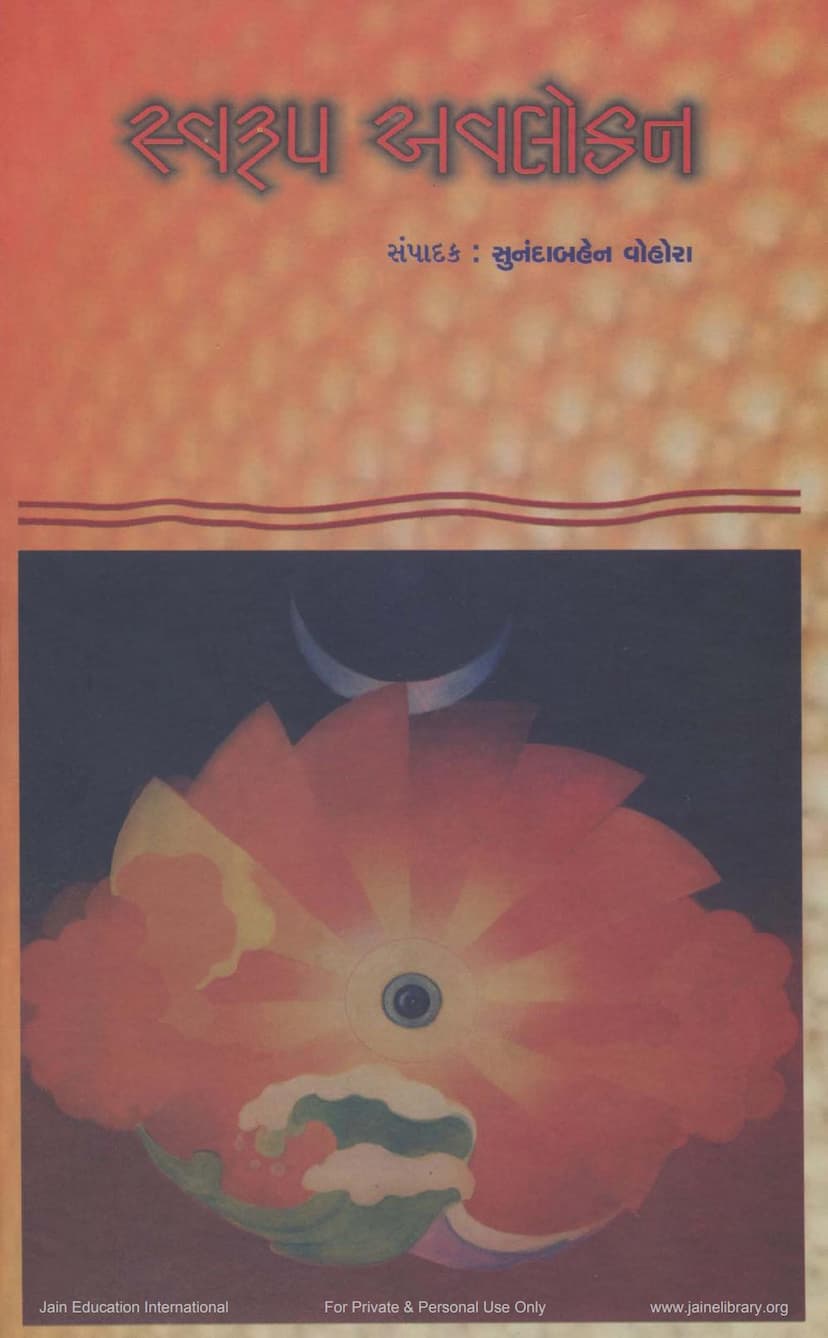Swarup Avalokan
Added to library: September 2, 2025

Summary
Here's a comprehensive summary of the Jain text "Swarup Avalokan" by Sunandaben Vohra, based on the provided pages:
Title: Swarup Avalokan (Self-Observation) Author: Sunandaben Vohra Publisher: Sunandaben Vohra (Published by Parth International Educational and Research Foundation, Ahmedabad) Catalog Link: https://jainqq.org/explore/004901/1
This book, "Swarup Avalokan," is a collection of spiritual insights and guidance compiled by Sunandaben Vohra, based on her studies and experiences, particularly stemming from her early learning of the Karma Granthas under the tutelage of the late Pandit Pannachand Shah. The publication is dedicated to Pandit Pannachand Shah, acknowledging the profound spiritual guidance received from him.
Core Theme and Approach:
The central theme of "Swarup Avalokan" is the observation and understanding of one's true self (Swarup). The author emphasizes that the book's focus is not merely on scriptural verses or their literal meanings, but on extracting the essence of wisdom (Bodha) from them and applying it to one's inner life. The emphasis is on internal introspection and self-correction rather than external rituals or scriptural memorization. The text repeatedly highlights the concept of self-effort (Purusharth) in the spiritual journey towards liberation.
Key Concepts and Discussions:
The book delves into various aspects of Jain philosophy, with a strong focus on the doctrine of Karma. Here's a breakdown of the major themes discussed:
-
The Nature of the Universe and Self: The text posits that the universe is self-created and self-regulated (Swatparipranmi). No external entity creates or destroys it. The inherent nature of things is based on the principles of production, decay, and permanence (Utpad, Vyay, Dhruvya). The soul (Atma) is eternal and pure, but becomes tainted by association with karma.
-
Karma Siddhanta (Theory of Karma):
- Karma as the cause of worldliness: Karma is presented as the primary force that binds the soul and leads to the cycle of birth and death (Sansar).
- Types of Karma: The book details the eight types of karma (Jnanavaraniya, Darshanavaraniya, Vedaniya, Mohaniya, Ayushya, Nama, Gotra, Antaraya) and their specific effects. It explains how karma is acquired through thoughts, speech, and actions driven by passions (Kashayas) and ignorance (Ajnan).
- Karma and its effects: The text emphasizes that the fruits of karma are reaped according to their nature and timing, not always immediately. This explains the apparent disparity between good deeds and suffering, or bad deeds and happiness, in the present life.
- Liberation from Karma: The path to liberation involves controlling the influx of new karma (Samvara) and shedding existing karma (Nirjara). This is achieved through right faith (Samyak Darshan), right knowledge (Samyak Jnan), and right conduct (Samyak Charitra) – the Three Jewels (Ratnatraya).
- Nirjara (Shedding Karma): The book distinguishes between Sakam Nirjara (intentional shedding of karma through conscious effort and spiritual practice) and Akam Nirjara (unintentional shedding of karma). True spiritual progress lies in Sakam Nirjara.
- Moksha (Liberation): The ultimate goal is to shed all karma and achieve the soul's pure, liberated state (Siddha-pada).
-
The Role of the Soul (Atma) and Consciousness (Chaitanya): The Atma is described as the pure, conscious principle that remains unchanged, while its states (Paryaya) are subject to karma. Consciousness (Chaitanya) is the essence of the soul.
-
The Five Senses and the Mind: The text discusses how the mind and senses interact with external objects, leading to attachments, aversions, and the consequent binding of karma. It advocates for controlling the senses and the mind, turning the focus inward towards the soul.
-
The Importance of Right Faith, Knowledge, and Conduct (Samyak Darshan, Jnan, Charitra): These are repeatedly stressed as the path to spiritual progress. Right faith means having unwavering belief in the eternal truths of Jainism. Right knowledge involves understanding the true nature of reality. Right conduct is the practical application of this knowledge in daily life.
-
Specific Practices and Concepts:
- Ahimsa (Non-violence): The principle of non-violence is fundamental, extending to thoughts, words, and deeds, and is crucial for minimizing karmic bondage.
- Tapa (Austerities): Austerities are presented as a means to weaken passions and shed karma, but must be undertaken with the right understanding and intention.
- Samayika and Pratikraman: These are highlighted as essential practices for self-purification, self-observation, and taking refuge in the divine principles (Dev-Guru-Dharma).
- The Nature of Desire (Trishna) and Attachment (Moha): These are identified as the root causes of suffering and continued bondage.
- The Soul's True Nature: The ultimate aim is to realize the Atma's inherent pure, omniscient, and blissful nature.
-
The Significance of Human Birth: The human birth is considered a rare and precious opportunity for spiritual progress and the attainment of liberation, due to the presence of higher consciousness and the ability to exercise free will.
-
The Importance of the Guru: The guidance of a learned and spiritually realized Guru is considered indispensable for understanding the subtle principles of the soul and karma.
Structure and Tone:
The book is presented as a series of spiritual discourses and reflections. The tone is instructive, empathetic, and encouraging. The author shares personal anecdotes of her own spiritual journey and challenges in understanding and applying these principles. The language is accessible, aiming to impart deep philosophical concepts in a relatable manner. The emphasis on "Swarup Avalokan" (self-observation) implies a practice-oriented approach to spirituality.
In essence, "Swarup Avalokan" is a guide that encourages readers to look within, understand the nature of their actions and their karmic consequences, and to diligently pursue the path of self-purification and self-realization as taught in Jainism, ultimately leading to liberation from the cycle of birth and death.